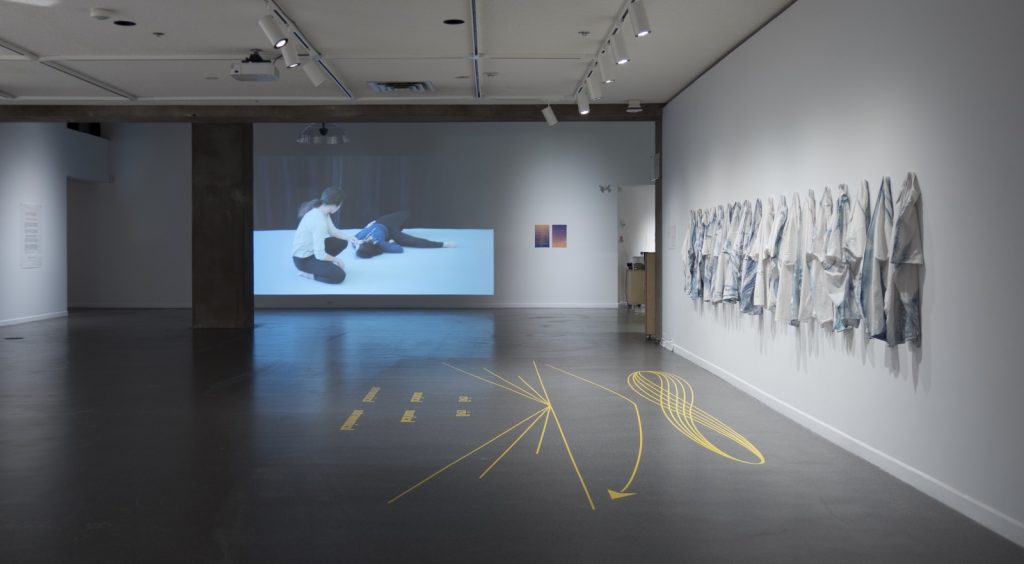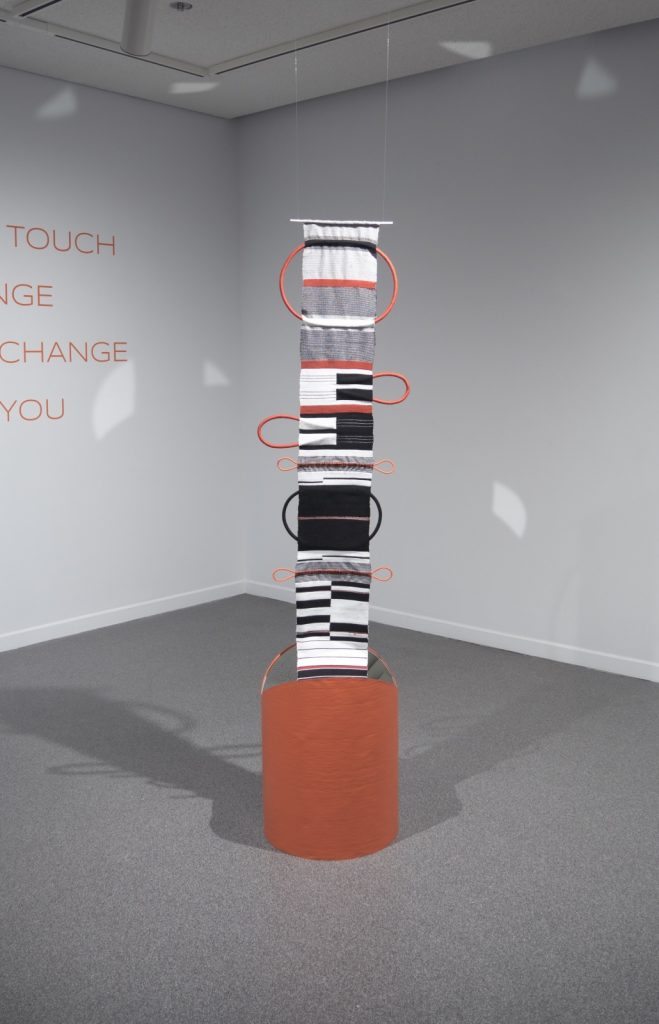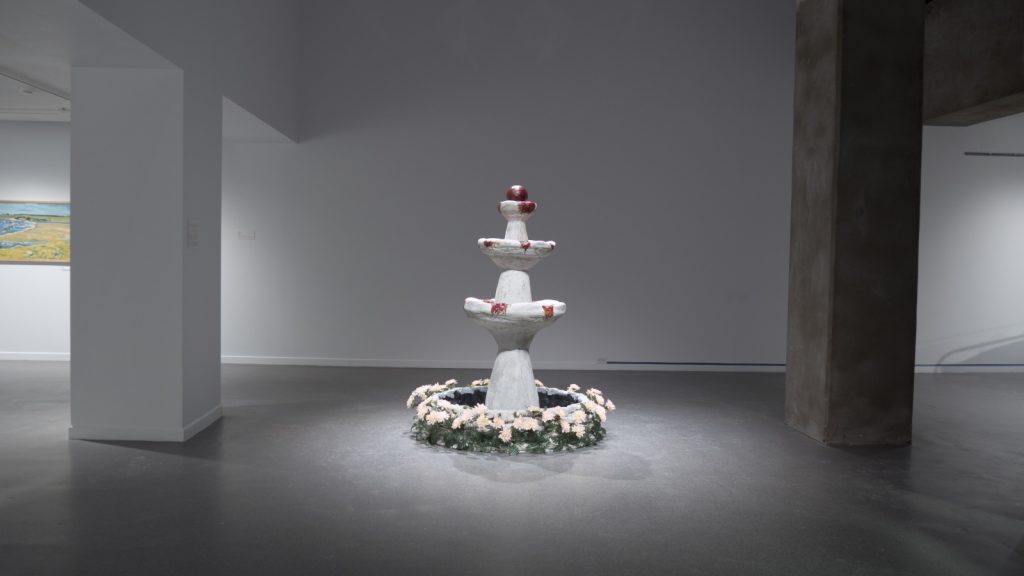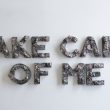
Gut Feeling showcases a roster of artists who, in Halifax, are nothing short of beloved. Even on a snowy night in a busy week of exhibition openings, Dalhousie Art Gallery was packed with friends and community members who are deeply devoted to the artists featured. Many artists have practices that intersect with their roles as community organizers and activists, such as Elise Boudreau Graham who co-runs Friends and Neighbours Gallery in a Montréal apartment and Shaya Ishaq who is a co-creator of Black Lit and, as an individual artist, creates libraries of Black literature. The atmosphere at the opening was palpable, supportive, and high-energy. The exhibition’s online description spoke of gut biomes and bacterial interactions between bodies that exchange, collaborate, and change one another. It promised a curatorial paradigm that put communal artistic practice under the microscope to examine how it is intuitive, innate, or embodied on a cellular level. By contrast, the exhibition description on the gallery wall seemed like an apology for not meeting this vision, or an attempt at curatorial modesty. The new description read:
There is no ‘theme’ in this exhibition linking the artists or works together. Instead we chose to work with artists we felt would respond well to our vague notion of a group exhibition and access the Gallery and its resources. In the development of our process, we noted that we were working intuitively, from our gut: / Gut biome, more bacteria than body; if we touch, our biomes change. Biomes exchange, collaborate, and change one another, intuiting needs through intricate communication.


At the opening and the artist talk, there was no mention of gut biomes, and by writing about their own framework as “vague,” Glanzmann and Johnston undersold the nuanced connections that developed naturally between the works. The overwhelming community support for this exhibition shows that the curators should not have lost faith in their original vision. Some artists who may have been considered “emerging” when the exhibition was proposed have, by my standards, surpassed that category today. Perhaps by some curators’ standards these artists— many nationally-exhibiting, and one longlisted for the Sobey Art Award—could fall into this inflated label. Dobbin called into question this category which framed the exhibition by presenting a “retrospective” of their own work created at age eleven. Dobbin’s tongue-in-cheek response to the exhibition exposed what many of us were thinking: that the slow turnaround of exhibitions in major art galleries cannot possibly keep its finger on the pulse of emergent practices. While group exhibitions have the potential to launch the careers of emerging artists, they can also expose the systems that hold them back.
Several artists responded to the architectural and institutional structure of their surroundings in Dalhousie Art Gallery, including Lou Sheppard, who mapped every path that one could take in the building without a key. Elise Boudreau Graham created an installation that celebrated her father Russel Graham, who worked as an electrician at Dalhousie. By painting a line where the electrical conduit runs between two outlets, Boudreau Graham highlighted the technical labour of her NSCAD-trained father in the space of the gallery. Emily Davison and Elyse Moir replayed the script of a past artwork by renowned conceptual artist Gerald Ferguson, which is housed in Dalhousie Art Gallery’s permanent collection. In 1984, Ferguson hired an assistant to create landscape paintings based on Nova Scotia postcards, and the resulting work was mainly accredited to Ferguson. In response, Davison hired Moir to produce 60 postcards (which doubled as time cards to clock in and out of work) based on the four original paintings. It’s as though Moir played broken telephone, by reinterpreting the four repeated images over the course of her shifts as a contracted worker. Scribbled on one of Moir’s sketches it read, “I hadn’t been thinking of the pedagogical implications of the Assistant / Artist relationship.” Davison and Moir jointly share credit, copyright, and future exhibition fees for the work, calling into question the systems of apprenticeship that have traditionally defined emerging artists.
Stephanie Yee’s sweet and sour sauce fountain created a sticky aroma at the entrance of the gallery. Using this common motif found in many Chinese North American restaurants, Yee used the water feature to expose the racial prejudice behind the concept of tackiness and to interrogate the dual meaning of the word taste. In José Andrés Mora’s motorized installation, a screen loudly swung back and forth along a structural beam, displaying a statement in all-caps that was reminiscent of a scrolling news ticker. With each pendulum swing, the message on the screen reflected the movement as though to say “this, but also this, but also this.” The narrative arc of the text waffled with indecision as it scrolled back and forth, forgiving, congratulating, and apologizing to an anonymous reader.

Several artists took intuitive approaches to making, appropriately following the logic of the exhibition’s title. Lou Sheppard’s graphic compositions translated data into dance notation and audio scores, which were then interpreted by dancers. The dancers negotiated space, testing out new postures as they tentatively explored the contours of Sheppard’s notation. Though Sheppard’s work appears to follow a rigid, linear process of translation, it frays the hard disciplinary seams of traditional research by operating in an exploratory manner. Adjacent to Sheppard’s work, the walls around Ishaq’s weavings were plastered with an Octavia E. Butler quote from Parable of the Sower, “ALL THAT YOU TOUCH / YOU CHANGE / ALL THAT YOU CHANGE / CHANGES YOU / THE ONLY LASTING TRUTH IS CHANGE / GOD IS CHANGE.” Ishaq followed Butler’s tenants of change while weaving, shifting techniques each time that a consistent pattern emerged in her fibre works. While the resulting weavings follow winding narrative paths, they are far more balanced than they are spontaneous. The meticulous bands of colour often mirror one another, and Ishaq demonstrates the regularity of change as a consistent inevitability.
The tenuous relationships between the works in the show demonstrate that the curators had the right instincts when drawing together these artists. They certainly followed a clear methodology by relinquishing curatorial authority in order to offer agency to artists with communally-driven practices. Granted, their modesty bordered on self-deprecation, as though it was meant to shield them from criticism. In the past, I have heard Atlantic-based curators talk about a sense of inferiority that follows east coast artists, one that stops them from valuing their own statements, stories, and testimonies. It takes gall to draw a circle around a group of artists, claim a truth about them, and expose them to the eye of the critic. Though this risk of exposure can come at a price for a curator, the calibre of the work in this exhibition deserves and demands such a risk.
















Leave a Reply